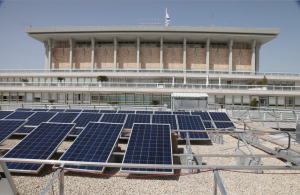The unveiling of the solar field on the roofs of the Knesset will take place on Sunday, March 29 with the participation of Knesset Speaker Yuli Edelstein. This environmental project is meant to make the Knesset the greenest parliament in the world.
A total of 4.65 dunams of solar panels have been installed on the Knesset roofs. This initiative is the largest and the most important in the Green Knesset project that was launched a year ago.
Knesset Speaker Yuli Edelstein: “The Green Knesset project is a project that spreads the vision of sustainability through the idea of ‘from Zion comes the Torah’. I am proud that the Knesset has become a model for the world on this matter and has already signed a number of international agreements for inter-parliamentary cooperation with an emphasis on Green Knesset.”
In the past few weeks, giant cranes have unloaded some 1,500 solar panels onto the Knesset’s roofs. These panels were created especially for the Knesset’s solar field, which is laid out over 4,650 square meters of the Knesset roofs and will have an installed capacity of 450 kilowatts. The solar array, which cost the Knesset NIS 2.4 million, will create some 10% of the Knesset’s electricity, and together with additional energy-saving measures, it will help reduce the Knesset’s energy use by a third.
The solar array is expected to save the Knesset NIS 300,000 every year. It will operate according to the net-metering method, under which electric energy generated by an electric consumer from an eligible on-site generating facility and delivered to the local distribution facilities may be used to offset electric energy provided by the electric utility to the electric consumer during the applicable billing period.
The Knesset’s solar array will be the first of any national institution to operate according to this method. Director General of the Knesset, Mr. Ronen Plot, hopes that other government institutions and local authorities will follow suit and establish solar fields of their own.
A year ago, in January of 2014, the Knesset launched the first part of its Green Knesset project. consisting of 13 approved and budgeted advanced projects for saving energy and water. The Knesset has invested NIS 7 million in all, and the yearly savings that will come from the project are estimated at NIS 1.5 million a year. All of the projects that were approved are economically viable and the project should pay for itself within five years.
The Green Knesset project includes not just the establishment of a solar field for the creation of electricity from renewable energy, but also the installation of thousands of LED lights, installing a new chiller in the energy center whose residual heat will be used to heat water, automatic shutdown of computers at the end of every workday, a review of the Knesset’s water usage for gardening purposes and changing to a more economical irrigation model and the desalination of the condensation of the air conditioning systems and using them for irrigation. In addition to the monetary savings, the energy savings will reduce the carbon output and therefore the carbon footprint of the Knesset.
The yearly savings will be transferred to the “Green Fund” which will be designated for the continuation of the “Green Knesset” project (for the creation of new initiatives). The Knesset’s Operations Division worked throughout 2014 in order to effectively complete most of the projects planned as part of the project’s initial phase.
Along with the technical projects, the Knesset’s Instructional Department and the Visitors Center carried out important measures aimed at instilling the values of sustainability among the visitors of the Knesset and the Knesset employees. All of the Knesset’s employees completed an internal course on sustainability, which focused on topics such as environmental ethics, environmental law and environmental economics. The employees also learned about water conservation, energy, waste and more.
During 2014, the Knesset continued to reduce the amount of waste it created and the unnecessary use of resources. It also recycled more. The Knesset committees, for example, are now serving water in glass pitchers rather than plastic bottles. In the past, some 60,000 plastic water bottles were supplied to the Knesset each year.
Knesset Secretary Yardena Meller-Horowitz requested that MKs send the Knesset Secretariat online queries rather than via hard copies. In addition, the Knesset Secretariat now sends Presidium decisions and reports on Plenum decisions by way of email to MKs. Similarly, the secretariat will not make hard copies of the bills for preliminary discussions until the MKs specifically request one. The Secretary explained that these steps were taken with the aim of better conduct with regards to the environment and as part of the Green Knesset project. She added that paper consumption is a large part of the environmental effort of the Secretariat and that it will save the Knesset between 40-50,000 sheets of paper a year.
As noted, one of the goals of Green Knesset is to bring the message of sustainability to other governmental institutions, and even to other parliaments. Recently, the Knesset has signed inter-parliamentary cooperation agreements with a number of countries, including Ethiopia, Kenya, Uganda, Albania and Romania. These agreements call, among other things, for the promotion of environmental values and projects.
Two large sub-projects are expected to be completed in the coming year. The first is the installment of new “chillers” that will be used to heat water in the Knesset. This will reduce the Knesset’s gas consumption by 50%. The second sub-project is the construction of an ecological research roof on top of the parliament building. Approximately 800 sq.m. of the Knesset’s roof area will be allocated to the green research project. The roof will be built in cooperation with the Kadas Green Roofs Ecology Center at the University of Haifa. Next to the green roof will be a photovoltaic system, in order to check whether the combination of the two increases the efficiency of the photovoltaic cells and the biodiversity of the roof environment.



















